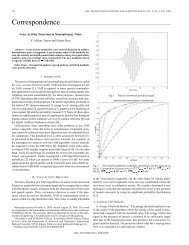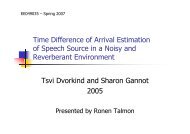Thesis (PDF) - Signal & Image Processing Lab
Thesis (PDF) - Signal & Image Processing Lab
Thesis (PDF) - Signal & Image Processing Lab
You also want an ePaper? Increase the reach of your titles
YUMPU automatically turns print PDFs into web optimized ePapers that Google loves.
14 CHAPTER 2. THEORETICAL BACKGROUND<br />
an edge links the corresponding vertices. Nevertheless, adjacency is not the only<br />
meaningful relation between regions. In addition, a hierarchy between regions can be<br />
created by building a tree based on a RAG, using a merging algorithm. A merging<br />
algorithm on a RAG is simply a technique, which removes some of the links and<br />
merges the corresponding nodes, creating new regions. When two or more regions are<br />
merged, a newly created region becomes the father of the original regions.<br />
To completely specify a merging algorithm one has to specify: the merging order<br />
(the order in which the links are processed), the merging criterion (each time a link<br />
is processed, the merging criterion decides if the merging has to be done or not), and<br />
the region model (when two regions are merged, the model defines how to represent<br />
the union). In the case of a Region Growing algorithm, the merging order is defined<br />
by a similarity measure between two regions (for example similar gray level), the<br />
merging criterion states that the pair of most similar regions have to be merged until<br />
a termination criterion is reached (for example a given number of regions has been<br />
obtained) and the region model is usually the mean of the pixels gray levels or color<br />
values. Note that the merging order (similarity between neighboring regions) is quite<br />
flexible and allows the definition of complex homogeneity models. By contrast, the<br />
merging criterion is very simple and crude: it states that the pair of most similar<br />
regions have always to be merged until the termination criterion is reached.<br />
Two examples of region tree representations are presented in [19] by Salembier:<br />
Max-tree (Min-tree) and Binary Partition Tree. An additional example of image rep-<br />
resentation, called Shape-Tree, is presented in [12, 13] by P. Monasse and F. Guichard.<br />
2.2.1 Max-Tree and Min-Tree<br />
The Max-tree (Min-tree) is a structured representation of the image, which is oriented<br />
towards the local maxima (minima) of the image. Each node V in the tree represents<br />
a connected component of the image, which is extracted by the following thresholding<br />
process: For a given threshold T , consider the set of pixels X that have a gray level<br />
value greater or equal to T and the set of pixels Y that have a gray level value<br />
equal to T : X = {x, such that f(x) ≥ T }, Y = {x, such that f(x) = T }. The<br />
tree nodes V represent the connected components Ci of X, such that Ci ∩ Y �= ∅.<br />
In other words, the nodes of the tree represent the binary connected components,
















